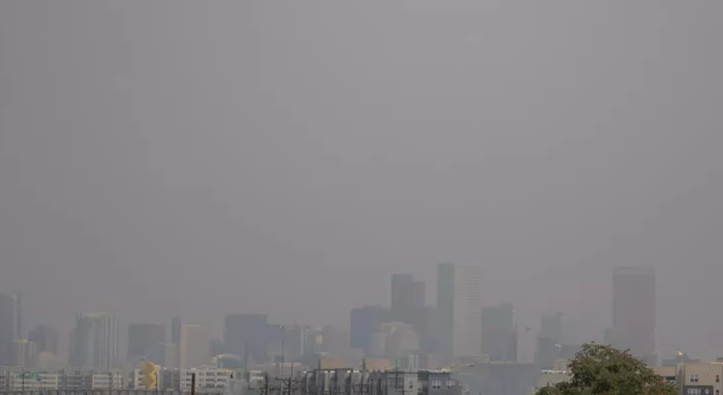
Evan Semón

Audio By Carbonatix
Denver is often thought of as a mountain town with crisp, fresh oxygen to breathe, but the Mile High City’s air quality is largely in the toilet. From daily air measurements in the summer to annual ozone levels, Denver is regularly near the bottom of major cities, and it’s still not shaken a brown cloud reputation dating back to the ’80s.
Denver’s Brown Cloud
Reports of bad air in Denver didn’t start in the 1980s. They date back to the 1880s, when a newspaper article reported that “bad air was hurting the city’s reputation.” Frustrations over poor air and a layer of haze over the city grew over the next century, but federal and state laws didn’t really try to curb local pollution until the 1970s. Those efforts weren’t fast or effective enough to stop the brown cloud from hanging around for the next decade, however.
A mixture of industrial pollution, car exhaust, dust, wood burning and other contributors, the brown cloud over Denver had a national reputation by the 1980s. After the Denver Broncos were blown out in Super Bowl XXII in 1988, CBS Evening News reporter Bob McNamara got in one more dig, saying the 42-10 loss to the Washington Redskins (now the Commanders) must be hard to swallow “for a town that’s never been number one in anything but carbon monoxide levels.”
This year, make your gift count –
Invest in local news that matters.
Our work is funded by readers like you who make voluntary gifts because they value our work and want to see it continue. Make a contribution today to help us reach our $50,000 goal!
Local mandates in Denver requiring cleaner-burning fuel helped flush away that brown cloud in the ’90s, but the city still struggles with air quality – largely because of Denver’s location.
Front Range Geography
Denver’s high altitude and proximity to ski towns and snow-capped mountains might evoke thoughts of clean air, but those actually contribute to the city’s bad breathing. According to the University of Colorado School of Public Health, wind velocity increases as it crosses over Colorado mountain ranges, hitting drought-stricken valleys in the Front Range and San Luis Valley and kicking up soil. The Front Range’s strong wind patterns are “unique” and “frequently trap air pollution, curdling it into a dense, visible layer,” according to NASA.
Denver’s high altitude also causes more temperature fluctuation, trapping pollutants close to the ground and requiring combustion engines to work harder, creating more emissions, CU professors note. On top of being high in radon, a naturally occurring radioactive gas that can contribute to lung cancer, the Denver metro is also close to fire-risk zones and ranks high in ozone levels.
Denver Ozone
Denver’s ozone issue is different from the atmospheric layer that protects Earth from the sun’s rays. Closer to the ground, ozone is a pollutant made up of nitrogen oxide and volatile organic compounds that mixes with heat and sunlight. With such strong sunlight and bowl-like geographic position, Denver routinely has high ozone days in the summer.
The Environmental Protection Agency’s safety limit for ozone is 70 parts per billion. When ground-level ozone passes that mark, the state Air Pollution Control Division issues an alert to residents. According to the American Lung Association, the Denver metro was the sixth-worst in the country for high ozone days last year, with over forty ozone action alert days issued by local officials for Denver in 2024. The ALA’s limit for a passable city is three days.
Wildfires in Colorado and Beyond
Denver’s geography has always put the city at risk of wildfire damage and pollution. But wildfires and wood burning have become bigger factors in Colorado air pollution in recent years. According to the state Division of Fire Prevention & Control, all twenty of the state’s largest recorded wildfires have occurred since 2001, with the three largest all happening in 2020.
Wildfires release toxic pollutants like methoxyphenols and polycyclic aromatic hydrocarbons, such as fluorine, into the air, according to CU health school professor Dr. Kathy James. The smog is bad for our eyes, respiratory systems and overall health.
While wildfires in Colorado cause plenty of pollution in the Denver air, it’s not always generated within the state. In the summer of 2023, Denver was covered in a blanket of smog after smoke drifted in from wildfires in Canada.
Polluting Industrial Plants
The Denver area is home to several industrial plants that release pollutants in the air, notably the Suncor oil refinery in Commerce City. Considered one of the largest sources of air pollution in Colorado, the Canadian-owned plant is located just north of Denver zip codes that are listed as some of the most polluted in the country. According to a lawsuit filed by handful of Colorado enviornmental groups, more than 9,205 pollution and permit violations occurred at Suncor from 2019 to 2024, including exceeded limits for carbon dioxide, sulfur dioxide, volatile organic compounds, nitrogen oxides and hydrogen sulfide.
Also located around north Denver is the Purina pet food factory, which has been cited and fined multiple times by the state Department of Public Health and Environment for air and odor pollution.